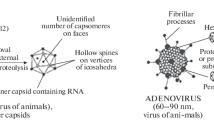Abstract
Since the seminal work of Caspar and Klug on the structure of the protein containers that encapsulate and hence protect the viral genome, it has been recognised that icosahedral symmetry is crucial for the structural organisation of viruses. In particular, icosahedral symmetry has been invoked in order to predict the surface structures of viral capsids in terms of tessellations or tilings that schematically encode the locations of the protein subunits in the capsids. Whilst this approach is capable of predicting the relative locations of the proteins in the capsids, information on their tertiary structures and the organisation of the viral genome within the capsid are inaccessible. We develop here a mathematical framework based on affine extensions of the icosahedral group that allows us to describe those aspects of the three-dimensional structure of simple viruses. This approach complements Caspar-Klug theory and provides details on virus structure that have not been accessible with previous methods, implying that icosahedral symmetry is more important for virus architecture than previously appreciated.
Similar content being viewed by others
References
Crick FHC, Watson JD (1956) The structure of small viruses. Nature 177: 473–475
Caspar DLD, Klug A (1962) Physical principles in the construction of regular viruses. Cold Spring Harb Symp Quant Biol 27: 1–24
Rayment I et al (1982) Polyoma virus capsid structure at 22.5 Ȧ resolution. Nature 295: 110
Liddington RC et al (1991) Structure of Simian Virus 40 at 3.8 Ȧ resolution. Nature 354: 278
Twarock R (2004) A tiling approach to virus capsid assembly explaining a structural puzzle in virology. J Theor Biol 226: 477
Twarock R (2005) The architecture of viral capsids based on tiling theory. J Theor Med 6: 87–90
Keef T, Twarock R (2007) Blueprints for viral capsids in the family of Papovaviridae. J Theor Biol (submitted)
Senechal M (1996) Quasicrystals and geometry. Cambridge University Press, London
Shechtman D, Blech I, Gratias D, Cahn JW (1984) Metallic phase with long-range order and no translational symmetry. Phys Rev Lett 53: 1951–1953
Bamford DM, Burnett RM, Stuart DI (2002) Evolution of viral structure. Theor Popul Biol 61: 461
Bamford DH, Grimes JM, Stuart DI (2005) What does structure tell us about virus evolution? Curr Opin Struct Biol 15: 655
Twarock R (2002) New group structures for carbon onions and carbon nanotubes via affine extensions of noncrystallographic Coxeter groups. Phys Lett A 300: 437–444
Patera J, Twarock R (2002) Affine extensions of noncrystallographic Coxeter groups and quasicrystals. J Phys A 35: 1551–1574
Janner A (2006) Towards a classification of icosahedral viruses in terms of indexed polyhedra. Acta Crystallogr A 62: 319
Janner A (2006) Crystallographic structural organization of human rhinovirus serotype 16, 14, 3, 2 and 1A. Acta Crystallogr A 62: 270
Tang L, Johnson K, Ball L, Lin T, Yeager M, Johnson J (2001) The structure of Pariacoto virus reveals a dodecahedral cage of duplex RNA. Nat Struct Biol 8: 77–83
Reddy VS, Natarajan P, Okerberg B, Li K, Damodaran KV, Morton RT, Brooks CL III, Johnson JE (2001) Virus particle explorer (VIPER), a website for virus capsid structures and their computational analyses. J Virol 75: 11943–11947
Keef T, Toropova K, Ranson NA, Stockley PG, Twarock R (2007) A new paradigm for symmetry reveals hidden features in the architecture of simple viruses (in preparation)
Valegard K, Liljas L, Fridborg K, Unge T (1990) The three-dimensional structure of the bacterial virus MS2. Nature 345: 36
Valegard K, Murray JB, Stockley PG, Stonehouse NJ, Liljas L (2002) Crystal structure of a bacteriophage RNA coat protein operator system. Nature 371: 623
Golmohammadi R, Valegard K, Fridborg K, Liljas L (1993) The refined structure of bacteriophage MS2 at 2.8 A resolution. J Mol Biol 234: 620
Toropova K, Basnak G, Twarock R, Stockley PG, Ranson NA (2007) The three-dimensional structure of genomic RNA in bacteriophage MS2: implications for assembly. J Mol Biol 375(3): 824–836
Grayson N, Keef T, Severini S, Twarock R (2007) Assembly pathways for bacteriophage MS2 based on a Hamilton path approach (in preparation)
Keef T, Taormina A, Twarock R (2005) Assembly models for Papovaviridae based on tiling theory. Phys Biol 2: 175–188
Keef T, Micheletti C, Twarock R (2006) Master equation approach to the assembly of viral capsids. J Theor Biol 242: 713–721
Author information
Authors and Affiliations
Corresponding author
Rights and permissions
About this article
Cite this article
Keef, T., Twarock, R. Affine extensions of the icosahedral group with applications to the three-dimensional organisation of simple viruses. J. Math. Biol. 59, 287–313 (2009). https://doi.org/10.1007/s00285-008-0228-5
Received:
Revised:
Published:
Issue Date:
DOI: https://doi.org/10.1007/s00285-008-0228-5




